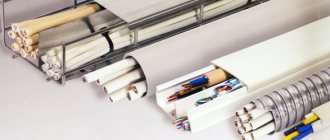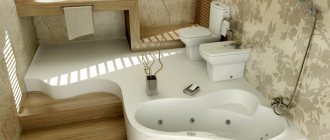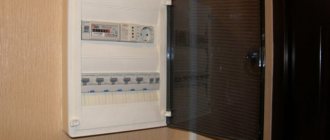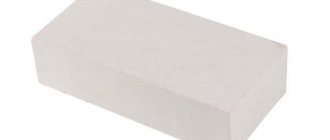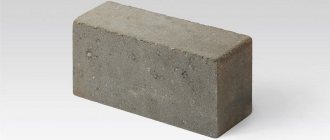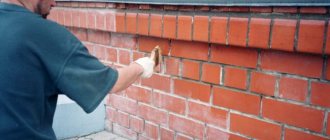Choosing a power tool for drilling holes in masonry
The main power tool that can be used to drill into a brick wall is a hammer drill or impact drill. A conventional household drill has less power and, according to its technical characteristics, is not designed for long-term operation with high loads that arise when drilling large-diameter holes.
If a construction hammer is not available, the household drill used must have a switch for impact drilling, a power of at least 600 W, the ability to smoothly regulate the speed; a reverse mode may be useful during operation.
Drilling without dust
When drilling walls, especially the ceiling, flour and grains of sand from the drilled material scatter throughout the room. This happens because an impeller is installed inside the drill to cool the engine, which, rotating, sucks air into the drill body from the side of the handle, and throws it out heated in the chuck area. This measure makes it possible to make a drill of greater power with small dimensions and protect the drill mechanism itself from dust. And the question of how to protect your home from dust when drilling is left to the owner to decide. I present a simple design that allows you to drill without dust.
The drilling jig for dust-free drilling is a modified previous version, but the shelf is replaced by a part cut from a plastic bottle. A piece of 9-11 ply plywood measuring 80x150 mm is cut out, and a hole with a diameter equal to the diameter of the drill plus 1 mm is drilled at a distance of 30 mm from the edge along the center line. On the side where the sandpaper will be glued, a trapezoidal cut is made with a depth of 2-3 layers of plywood. The sample will serve as a kind of air intake during drilling.
A part is cut off from a plastic bottle so that the remaining part can be attached to the conductor. The width of the base of the conductor is selected based on the size of the bottle. I took a square bottle, but any 1.5 liter bottle will do. Insulating tape is wound onto the threaded part of the neck of the bottle until it reaches a size equal to the inner diameter of the suction pipe of the vacuum cleaner. When the bottle is bent, holes are formed to form the required configuration. We close them with pieces of the remaining plastic from the bottle and secure them with a stationery stapler. You can close them with tape. There is no need for tightness here. Gaps of a few millimeters will not matter, since the suction power of even a low-power vacuum cleaner is excessive.
Then, using a furniture stapler, the formed part of the bottle is secured along the perimeter of the end of the base of the conductor, on the side where the sandpaper is not glued. We make a hole in the bottle for the drill. It is better to use the melting method, since the edges forming the hole will become thicker and last longer. I melted it with a soldering iron. You can melt a hole with a nail heated on a gas stove until red.
We connect the vacuum cleaner, turn on the minimum suction power, and do test drilling.
The result will make you very happy. You will not find a single speck of dust in the circle or brick flour on the drilling surface!
With prolonged use, the drill chuck, like a screwdriver, wears out, begins to hold the drill bits poorly and it becomes difficult to clamp them. The technology for replacing the drill chuck of a drill or screwdriver is discussed in the article on the website “Drill repair - replacing the chuck.”
Preparing to drill a brick wall
Before you get to work and start drilling into the wall, you need to make sure that there are no obstacles in the wall in the form of electrical wiring or water pipes. A metal detector can help with this: by pointing the device at the wall, you can detect an obstacle in time and thereby determine a safe point for drilling.
To correctly drill through any brick wall, the first step is to make a mark on the wall. For marking, a tool such as a center punch is used, which is a pointed steel rod. A center punch is used to drill a small hole in the wall, making it possible to fix the drill in a level position.
Preparatory work: positioning relative to the brick wall
Preparatory work regarding the brick wall itself immediately before drilling is more of an informational nature than a “strategic” - design one. From the point of view of safely performing such work, it is necessary to use the metal detector that was indicated in the list above.
Its practical application immediately before drilling will eliminate the possibility of damage to wiring, internal heating systems, as well as various reinforcing components.
Marking sockets, switches and lamps is the final stage of preparation. Taking into account the features of laying electrical wires from the above-mentioned “points” to the distribution box, and this is usually a vertical laying, but not excluding the possibility of a diagonal one, we determine the drilling location.
Despite the expected accuracy in choosing the drilling location, the first 10-20 mm deepening must be done with a screwdriver. Using this will allow you to timely identify communications recessed in the plaster, as well as avoid their critical damage.
Dust-free drilling
If drilling is being done in an already renovated area, you always want to avoid contamination or damage to the finish. This will not happen if you attach a shelf made of the same material to the bottom of your stencil. Your wallpaper or paint will be protected, and dust from drilling will linger on this shelf.
Note! You can use a regular tetra pack (milk carton) by cutting it in half. On one side, you need to cut a little more with scissors so that the paper does not interfere with the drill.
And a few more words about how to make a hole in a large brick wall or create a small niche.
In home repairs, a Pobedit drill can easily cope with this task:
- Mark the outline of the hole on the wall.
- Perform several drillings along the marked line in 10 mm increments.
- Use a hammer and chisel to remove any unwanted material.
If you need to go to a greater depth, and the length of the drill does not allow it, do the work in two or more approaches.
Jig for drilling holes without dust
Due to the heterogeneity of the walls, especially those made of brick, the drill often “leads” away from the intended place and if there is more than one hole, then the suspended shelf does not hang horizontally or, even worse, it is impossible to hang it, since the installed dowels do not coincide with the mounting ones loops. You can use a jig in the form of a sheet of plywood with a pre-drilled hole, but when drilling due to vibration it can also move and again the result will not be what was expected. But there is a simple technology that allows you to drill two or more holes strictly in specified locations.
Precise hole drilling
It turns out that the problem can be solved very simply by gluing a sheet of any sandpaper with glue or double-sided tape to the entire area of the side of the conductor that is attached to the wall. At the same time, the adhesion of the jig to the wall surface increases many times over, and during drilling, the specified accuracy of positioning of the jig is ensured. The hole will appear exactly at the marking location.
Depending on the weight of the product and the density of the wall, you have to drill holes for dowels of different diameters, usually 6 or 8 mm. For the versatility of the jig, it is necessary to drill several holes of the desired diameters with an ordinary drill.
To top it off, attach a plate to the end of the base of the conductor at a right angle. Thanks to this modification, most of the drilling products will remain on this shelf, which will prevent contamination of the wallpaper and reduce the scattering of dust in all directions.
The proposed device is also indispensable when drilling holes for attaching skirting boards. Drill a hole in the jig at a given height from the shelf. When drilling, place the shelf on the floor and all the holes will be exactly at the required height from the floor, which will guarantee a tight fit of the plinth to the floor surface.
Sometimes you have to hang a product on the wall, for which you need to drill several holes in the wall and maintain the distance between them with greater accuracy. If the wall is brick and plastered, then it is impossible to perform accurate drilling without a jig.
To make a jig for precision drilling, a board, sheet of plywood or metal is suitable. After marking, the required number of holes is drilled in the sheet using an ordinary drill. Consider the case for fastening the product with two screws. One hole is drilled with a diameter equal to the diameter of the drill that will be used to drill the wall, the second with a diameter equal to the diameter of the self-tapping screw. After the jig is made, the first hole is drilled in the wall using the jig for the precision drilling described earlier, and a dowel is driven into the hole.
The jig is screwed to the wall using a self-tapping screw into the hammered dowel and leveled using a water level so that the drilled holes are on the same horizontal plane.
Thanks to the use of a simple jig, which can be made in a few minutes from any available material, the holes were created exactly at a given distance from each other.
Using the same technology, you can drill a whole series of holes at a greater distance from each other. In this case, first the outer holes are drilled using the technology described above, the jig is screwed with two outer self-tapping screws, and then all other holes are drilled.
The proposed options for conductors are convenient when renovating an apartment, when dirt is common everywhere. However, when the renovation is completed and cleaned up, drilling becomes stressful. You don’t want to stain your carpets and furniture with concrete or brick chips and dust.
Construction of houses
Quite often there is a need to drill holes in brick walls. However, the technology for carrying out this process directly depends on the drilling location and the size of the required hole. Let's look at how to drill a hole in a brick wall below.
Table of contents:
- Drilling holes in a brick wall: technology and methods
- Technology for punching holes in a brick wall
- Instructions for making a hole in a brick wall
Drilling holes in a brick wall: technology and methods
Most often, drilling holes in brick walls is associated with the improvement of a house or apartment whose walls are made of brick. In order to build an internal outlet or hang shelves, mirrors, or a TV, you need to make holes in the wall.
However, for installing small items such as photo frames or small paintings, a small nail is sufficient. In this case, there is no need to drill the wall.
In order to drill a wall, all you need is a modern electric tool, such as an electric drill, and the skills to work with it. With the help of a special conductor, it is possible to get rid of dust generated during drilling.
In order to drill into a wall made of brick or concrete, a hammer drill is most often used. However, the cost of this tool is very high, and most often, in its absence, an impact drill is used.
How to drill a wall
A better tool than a hammer drill for drilling holes in brick and concrete walls has not yet been invented. But rarely does anyone have the luxury of having such an expensive tool on their household. Usually buy an electric impact drill.
Drill selection
When purchasing an electric drill, you need to be guided by the following technical characteristics.
The power of the drill must be at least 600 W. Revolutions up to 2500 per minute and the ability to smoothly adjust them from zero to maximum. The presence of reverse rotation (switch for the direction of rotation of the drill clockwise or counterclockwise). The best chuck is a quick-release chuck; you won’t have to waste time clamping drills and constantly searching for a lost key. The diameter of drills clamped in the chuck is up to 12 mm.
The presence of a switchable hammer drilling function. Of course, when this function is enabled, the drill will not become a full-fledged hammer drill, but drilling walls will be much easier and faster, and here’s why. Brick, cement and concrete withstand static load - pressure very well. But they are easily destroyed by dynamic influences - impact. Karatekas, with a strong blow, easily break a brick in two with the edge of their palm. When drilling with a drill without a hammer function, there is simply pressure from the drill and it is difficult for the cutting edge to catch on to the material, so drilling is slow and the drill becomes very hot due to friction. Drilling with impact is completely different. Upon impact, the drill punctures a part of the material with its cutting edge, and, falling with an impact into the formed recess, breaks off a portion of particles of the material. Something similar to chiseling is happening.
Read also: Cozy heater reviews from owners
Drill selection
Walls made of wood, plasterboard, and foam concrete can be successfully drilled with an ordinary drill. For walls made of brick, stone or concrete, you need a carbide drill. It differs from steel by cutting edges made of carbide material welded onto a regular drill, usually Pobeda. Less commonly, artificial diamond.
The pobedite insert is clearly visible at the end of the top drill. It is enough to have 2 Pobedit drills with a diameter of 6 and 8 mm on the farm.
Using drills with pobedite surfacing, you can drill a hole no more than 10-15 cm deep. For drilling to greater depths, for example, to drill through a wall, use a drill. Drills for drilling brick and concrete walls are up to one meter long and are designed for drilling holes only with a hammer drill. Even the cutting edges of the drill are made not sharp, but rounded to increase their wear resistance. A drill with a hammer function can also be successfully drilled with a drill.
Drills come with a shank diameter of 10 and 18 mm, with special grooves of the SDS+ or SDS-max standard for fastening, but they also clamp well in a regular jaw chuck. The standard and diameter of the drill are stamped on its shank.
If you need to drill through a thick wall, for example half a meter, then the passage is carried out in several stages with drills of the same diameter, but of different lengths. This is necessary for safety and faster drilling. First, drill the wall with a 20 cm long drill to a depth of 10-15 cm, then with a longer drill to a depth of 30-35 cm and finish drilling with a 50 cm long drill. The drill for such work must be powerful enough. Of course, the drill is not designed for such a load and its use is permissible only in exceptional cases. To perform this type of work, it is better to rent a real hammer drill.
Drilling technology
There are three ways to drill a hole in a brick wall: manual, electromechanical and automatic.
However, before starting work, it is necessary to study the location of the electrical wiring, since accidentally touching the wiring line will not only damage it, but can also electrocute a person. Most often, electrical wiring is located vertically or diagonally relative to sockets and switches. If you have any doubts, you should use a special device to detect hidden wiring. A portable metal detector will help detect aluminum or copper wire located no deeper than 1 cm.
A portable metal detector will help detect hidden communications
Hand Drilling Technology
In the absence of an electric tool, drilling holes can be done using a bolt. To do this, locations are pre-marked by drilling with a punch. After this, the bolt, which is applied to the wall at an angle of 90 degrees, is struck with a hammer. Every three blows, the bolt is rotated, and the remaining bricks are removed from the pipe. Thus, the hole is knocked out until it reaches the required depth.
Electromechanical process
Mechanical drilling is performed with a hammer drill or hammer drill, the process is the same.
First you need to decide on the type (through, not through), depth and diameter of the hole. This is necessary for a properly selected drill or drill. If you have difficulty maintaining the same distance between the holes, you can use a template. The stencil is made from plywood, chipboard, plastic and other available materials. To use it, you need to secure the sandpaper on one side with double-sided tape or glue, then lean it against the wall and drill.
After the type and diameter of the future hole has been determined, markings should be made with a core. The drilling process will be easier if it is done in the seam between the bricks. Notches with a core are made in order to fix the drill and facilitate its entry. When drilling with a drill, the tool must be held perpendicular to the wall, pressing gently on it so as not to break the drill or drill. Periodically, the drill must be taken out for cooling in a container with cold water.
If it is necessary to drill a hole with a diameter greater than 18 cm, a hammer drill with diamond bits is used. If these are not available, you can use Victory drills of regular diameter. For this:
- The location of the future hole is outlined, and its outline is outlined with a pencil.
- Drilling is done along the outside of the line; the number of holes depends on the diameter of the contour. The diameter of the drill itself should be 0.8-1.0 cm, the pitch of the holes along the contour should be 1.0 cm. To do the job more accurately, you can use drills with an even smaller diameter, but then the process will take longer.
- Using a chisel and hammer, a sample is made from the drilled contour.
If you need to drill through a thick wall, you can do this in two stages: first, perform the drilling process as described above on one side of the wall. Then, the center of the resulting hole is drilled through. After this, the required diameter is marked on the other side of the wall around the intended through center, and the process is repeated.
Automatic process
Diamond drilling is carried out using professional, expensive equipment. In this case, it is desirable to have special skills and qualifications. With the help of such a tool, the drilling process is fast, accurate, almost silent, and can be done at different angles to a depth of up to 40 cm, resulting in a smooth hole, without chips or cracks. This method does not create a lot of dust and dirt, since the tool is equipped with an attachment to cool the drill and wash away the dust.
Drilling holes in brick
Drilling should begin with a pilot hole, which is made with a drill one number finer than necessary. Make sure that the drill you choose is suitable for its purpose, length and diameter.
It is also worth paying attention to its condition - the equipment must be level and free of dirt. When drilling, a drill or hammer drill must be set to low speed mode. Hold the tool with both hands - the main and auxiliary handles. You need to drill strictly perpendicular to the wall, since displacement even by a small angle increases the risk of drill breakage and reduces the reliability of fastening in the future.
In the event that drilling is performed with the most ordinary drill, without the ability to adjust the speed, take breaks every second to allow the drill to cool and not damage the motor and gearbox of the tool. Once the pilot hole has reached the required depth, remove any dust from it using a vacuum cleaner and begin working with the main drill.
Registration: Well, really, no one has drilled a single hole in a single brick? Well, at least tell me if it will crack?
Forming a hole for a pipe using construction components
In addition to the tool, you need to be able to choose the right nozzle. Usually for one tool there are several sets of drills and attachments for different types of work. Even for one action, manufacturers offer several options for how it can be carried out.
Drill
A drill for a power tool when working with a solid wall should have a Pobedit tip. The material is characterized by high strength and abrasion resistance.
Compared to similar drills made from other raw materials, Pobedit drills last longer. They are used many times.
Brick drills
The standard length of the element is 15 cm, intended purpose is household use. There are larger models for rotary hammers, the largest ones are called auger drills.
It is possible to make the desired hole with such a nozzle if you draw a circle. Then drill holes along the contour in 1 cm increments. The core is removed with a chisel and hammer.
This is the way out, if you don’t have a special drill for a hammer drill, have a spatula - it can be used to easily remove the central part.
